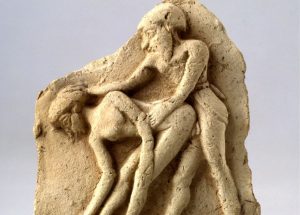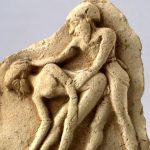Welcome to 3dmovies.xxx

According to Dr. Julia Assante, a Near Eastern social historian, the woman drinking beer from a straw was not just a reflection of lifelike sexual encounters, but was “undoubtedly a [visual pun].” The straw in the woman’s mouth and the man raising a cup of wine to his lips were symbolic of performing oral sex on their respective partners. The Babylonians, Assante writes, held “an exalted cultural view of sex as inducing an altered state of wonder.”
The terra cotta plaques from Mesopotamia yield numerous different sexual positions, but one of the most popular was what’s referred to technically by the Latin: coitus a tergo — from behind. While erotic Mesopotamian art doesn’t detail a specific means of entry, anal sex was deemed a popular means of contraception by ancient couples before the invention of prophylactics. The depiction of couples engaging in rear entry may be indicative of that practice. Other plaques show partners side-by-side, standing up (aka lleváme) and plain old missionary; some depict women with legs spread, squatting over a comically large phallus.
That the erotic clay plaques were found in temples, graves and private homes makes it difficult to generalize about their intended use, but is testament to their popularity. That excavators found the erotic artwork in high-traffic rooms of homes leads Assante to infer that they were accessible to men, women and children. Download



4,000-year-old erotica depicts a strikingly racy ancient sexuality
Clay plaques at The Israel Museum, made 1,500 years before the Kama Sutra, display graphically that Old Babylonian culture held an ‘exalted’ view of sex
Museums are often misconstrued as dusty and lifeless — the least likely place to find something hot and steamy. But the Ancient Near East section in The Israel Museum’s Archaeology Wing features rare erotic art from the land between the rivers (Tigris and Euphrates), which predates India’s Kama Sutra by over 1,500 years. Such astonishingly intimate works reveal a side to the ancient Near East that contrasts sharply with the modesty prevalent in the modern Middle East.
Two clay plaques, small enough to hold in your palm, depict couples copulating in remarkable detail. Dating from the early second millennium BCE, the Old Babylonian period, they come from a 300-year window when mass-produced terra cotta plaques were popular, including those that exhibit sexual acts.
Mesopotamian erotica was “really something racy,” Laura A. Peri, curator of Western Asiatic Antiquities, said when we met in the labyrinthine bowels of the museum. “It’s not all, you know, missionary and that’s it.”
The first plaque shows a man penetrating a woman from behind, while standing. The second, slightly smaller one, depicts a man and woman in a similar position, with the woman drinking beer through a straw from a jug.